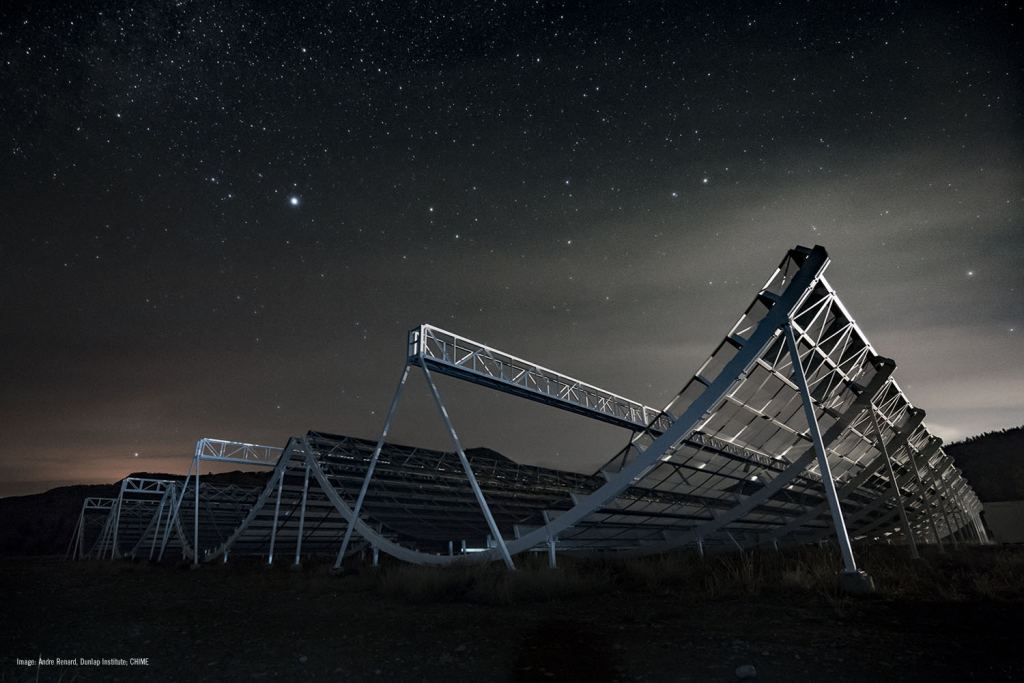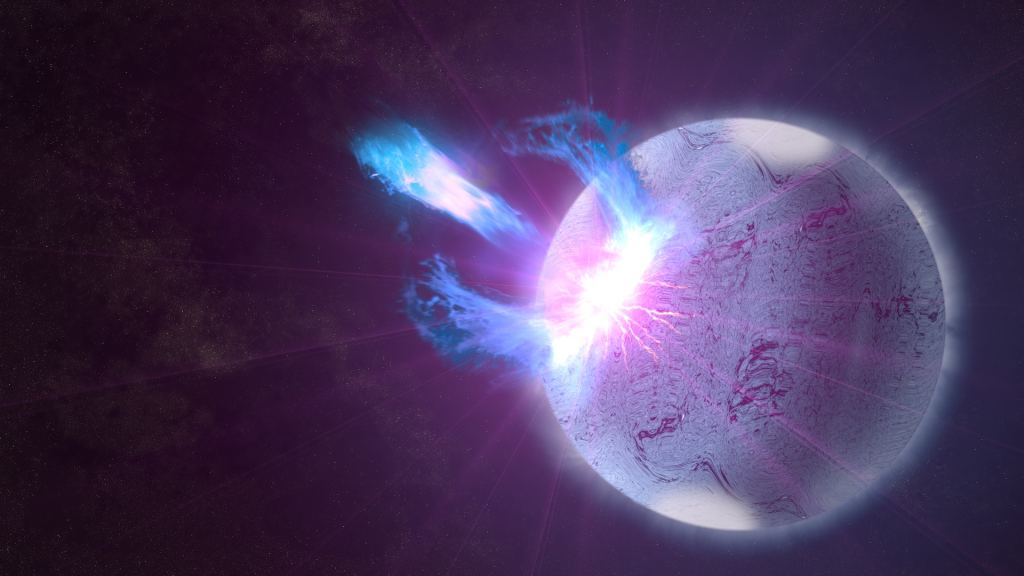A team of scientists in Canada have found a Fast Radio Burst (FRB) that repeats every 16 days. This is in stark contrast to other FRBs, which are more sporadic. Some of those sporadic FRBs occur in clusters, and repeat irregularly, but FRBs with a regular, repeatable occurrence are rare.
A Fast Radio Burst is a pulse of radio emissions that lasts only milliseconds. The first one was discovered in 2007 by astrophysicist Duncan Lorimer and his student David Narkevic, and is called the Lorimer Burst. Since that time, many more have been discovered, but their origin is still unclear, though we know their source is extra-galactic.
The team of scientists have published a paper presenting their findings. It’s titled “Periodic activity from a fast radio burst source.” They’re working with data from CHIME, the Canadian Hydrogen Intensity Mapping Experiment.
CHIME is a radio telescope, but it’s an unusual one. Rather than a dish which can be aimed at targets, CHIME is stationary, and has no moving parts. It consists of four half-cylinders, and each half-cylinder holds 256 dual-polarized receivers. Together that’s 2048 signals received for processing. CHIME watches a vast, moving swathe of sky as the Earth rotates.

The new burst is called FRB 180916.J0158+65, and it represents an unusual opportunity. Since most FRBs don’t repeat, there’s no way to do follow-up observations. But FRB 180916.J0158+65 repeats about every 16 days. There are about 10 other known FRBs that repeat, but they don’t repeat regularly.
In this case, the researchers were studying data from CHIME. Once they spotted this new FRB, they looked at past data, and found 400 observations of the new FRB. They determined that it repeats 16.35 days. The signals arrived about once every hour for a four day period, and then stop. Then about 12 days later they’d start up again.
Astronomers have been able to pinpoint the origin of the new FRB. It’s coming from an active star-forming region in a nearby massive spiral galaxy. It’s one of only four FRBs to have its source pinpointed like this, and of those four, it’s the only repeater.
Since astrophysicists still don’t know what creates FRBs, pinpointing their sources is a key part of understanding them. While this latest FRB is coming from a star-forming region in a spiral galaxy about 500 million light years away, other FRBs appear to have different sources. One, for instance, came from a low-metallicity irregular dwarf galaxy, indicating that there may be more than one source for FRBs.
But nobody really knows yet.

There are many theories of what could be creating FRBs, and mostly its speculative. But there are some constraints on those speculations.
Since FRBs only last for a few milliseconds, astrophysicists think there source might be small, something only a few hundred kilometers across. And since we detect them from such distant sources, their sources must be energetic.
Some think the FRBs may be connected to Gamma-Ray Bursts (GRBs). Or they might be created when massive objects collide, like neutron stars and black holes. Another possibility is magnetars, a type of neutron star with an extremely powerful magnetic field. Or maybe stellar flares. Some people, mostly not professionals, think these signals could come from an alien technological civilization.

There are more hypothesized sources, like extremely energetic supernovae, or pulsars collapsing due to dark matter. From there, the hypotheses get more and more exotic, like cosmic strings, explosive decays of axion mini-clusters, and pulsars that venture to close to supermassive black holes.
When there are that many candidate causes for a phenomenon, it means you don’t have much to go on.
Since FRB 180916.J0158+65 repeats, its source could be a stellar body in orbit around another body. In that scenario, the signal would be blocked by the other body in a regular periodic pattern. But that explanation only goes so far, and doesn’t suggest what the source is. In a press release, other possibilities are mentioned, including stellar winds. Those winds could alternately boost and block the signal. Or the source itself is a rotating body. Or some combination of factors could be responsible.
For now the source is still a mystery. But the source has been located, and if the new FRB maintains its repetitive nature, future telescopes might be able to pinpoint the source with more precision. If and when that happens, we might get our answer.
More:
- Press Release: Fast radio burst with steady 16-day cycle observed
- Research Paper: Periodic activity from a fast radio burst source
- Universe Today: New Canadian Radio Telescope is Detecting Fast Radio Bursts

